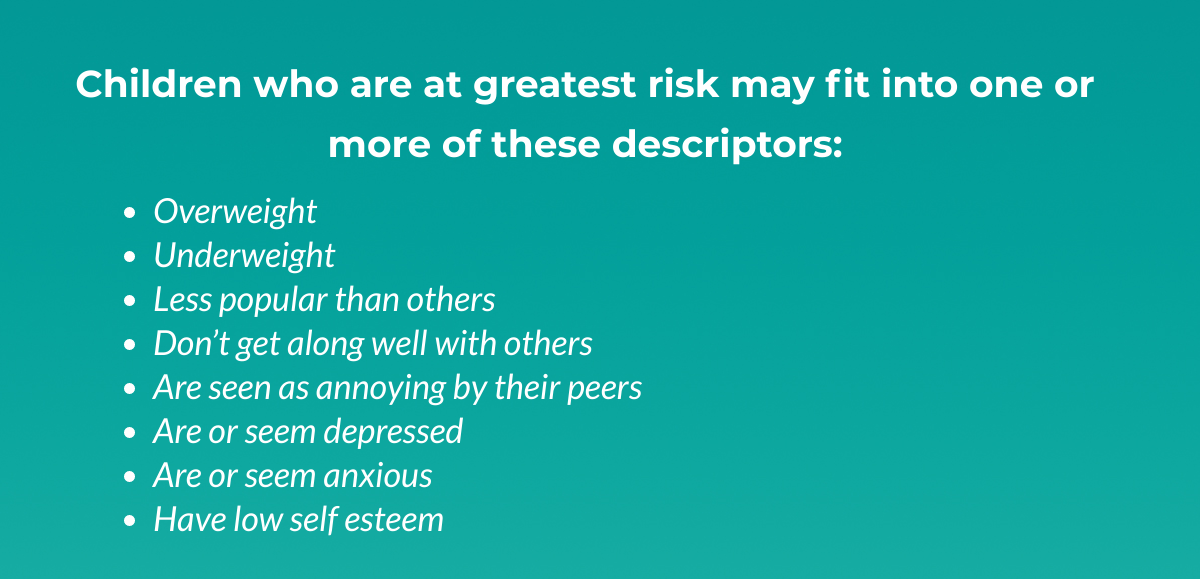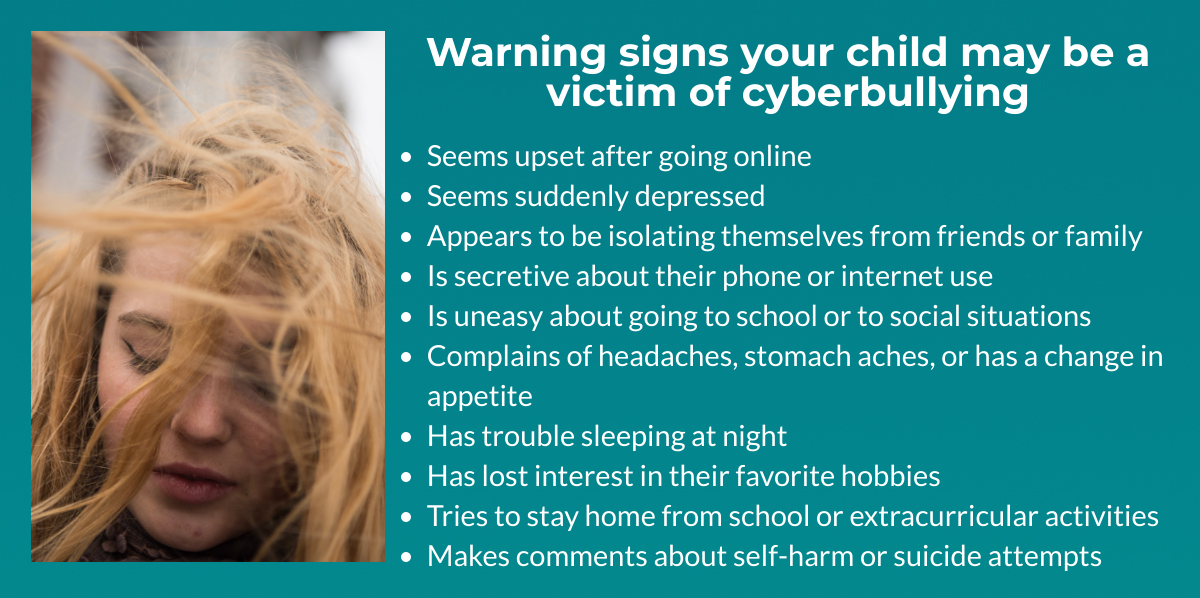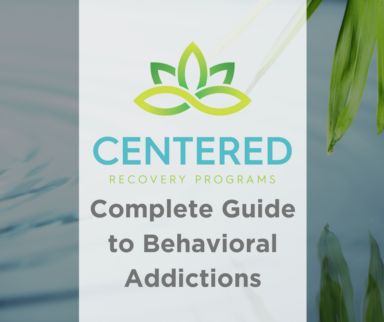What is cyberbullying?
Bullying is not a new phenomenon in our culture. There are references of bullying, typically among school aged children, in published psychology articles as early as the 1800’s (1). Bullying is defined as any unwanted behavior that is aggressive and includes an imbalance of power, such as physical strength or intimidation, in order to assert control or harm another.
With the proliferation of users on the internet starting in the 1990s, traditional bullying took a new form: cyberbullying. The definition of cyberbullying is using technology such as texts, photos, videos, tweets, private messages, or posting on social media as a means to bully a person. Cyberbullying is a form of harassment, and victims can often feel embarrassed, intimidated, or even threatened by these actions. The Cyberbullying Research Center (CRC), directed by Dr. Sameer Hinduja and Dr. Justin W. Patchin, was founded in 2005 and researches and publishes research for the public on the topic of cyberbullying. The CRC reports that teens and adolescents who are bullied online are also likely to be bullied in person, as issues which are raised online rarely stay solely online.
While bullying in the pre-internet days was rough, adolescents and teenagers were more slightly more able to limit their interactions with peers, especially those they wished to avoid. Simply going home from school for the day often allowed children a reprieve from bullying behaviors, where they could vent, get advice, and regroup before returning to potential bullying situations again. The internet allows bullies to continually engage in bullying behavior, regardless of where the victim is located. This inability to disconnect from their attackers is part of what makes cyberbullying such a huge mental health risk. Victims may feel that there is no safe space for them to relax away from their attacker, and may isolate themselves from using social media and/or their friends, which may compound the problem and make them feel worse.
Who is at risk?
Research published by the American Academy of Pediatrics in 2017 reported that students in grades 3-5 who owned cell phones were “significantly more likely to report being a victim of cyberbullying (2). However, children who are at the greatest risk for being bullied, either online or in person, are children who are perceived as being different from their peers in some way. Girls are just as likely as boys to experience bullying, both as victim and perpetrator.
Children who are at greatest risk may fit into one or more of these descriptors:
- overweight
- underweight
- less popular than others
- don’t get along well with others
- are seen as annoying by their peers
- are or seem depressed
- are or seem anxious
- have low self esteem
Effects of cyberbullying
Bullying, whether in person or online, can have serious and long-lasting effects for the victim, such as fear, anxiety, and depression. These effects can lead to changes in mood, sleep disturbances, affect the appetite, and potentially lead to harmful behaviors such as cutting or even suicidal thoughts or actions. The effects of cyberbullying can be wide and long-lasting, so while you shouldn’t jump to conclusions or escalate the situation, you should carefully assess your child’s mental and emotional well-being. Your child may try to mask their fear, anxiety, or upset from you, especially if they feel it is upsetting you. They may want to tell you everything one day, and other days not want to discuss it at all. Try to ensure they are sleeping well, eating healthy, and that other factors in their life such as homework and other responsibilities are well-managed to avoid adding additional stress.
Sometimes people who do not know how to manage the stress or pain of something they are dealing with may turn to harmful behaviors they can control as a sort of release. These could include lashing out at people they love, acting out behaviorally, engaging in physically risky behavior, self-harm, or suicide attempts. If you are concerned that your child may be engaging in self-harm behaviors or having suicidal thoughts, seek help from a qualified mental health therapist immediately.
Warning signs your child may be a victim of cyberbullying
It can be difficult to notice the signs of cyberbullying since the act itself may not be visible to you due to the technology involved. There are some common behavioral signs you should watch out for, and if you spot them, try to open a dialogue with your child to ensure they are okay.
If your child:
- seems upset after going online
- seems suddenly depressed
- appears to be isolating themselves from friends or family
- is secretive about their phone or internet use
- is uneasy about going to school or to social situations
- complains of headaches, stomach aches, or has a change in appetite
- has trouble sleeping at night
- has lost interest in their favorite hobbies
- tries to stay home from school or extracurricular activities
- makes comments about self-harm or suicide attempts
What can you do?
You may have to rely on communications with your child to know whether or not they are being hurt by someone online. You could also consider monitoring your child’s online activity, including their social media sites, browser history, and/or messaging. If you find evidence of bullying, save it by taking screenshots and sending a copy to your own phone. Having evidence of the bullying will help you if you decide to get school officials or anyone else involved. Review the privacy settings on your child’s phone and internet access, and make sure their accounts are set to “private” in order to limit access to their social media accounts. Have your child accept you as a friend on all social media sites they participate in so that you have access to what they post, and what others post to them as well. Require your child to give you their login and password to applications and websites they use so that you can check in, if needed. Familiarize yourself with the commonly used social media apps and websites and how they are used.
Most importantly, try to keep the lines of communication with your child open and honest. A child in need will mostly come to you for help if they feel they can trust you, particularly if they feel they can be honest with you without risking trouble or a lecture. Let your child know they can talk to you about anything, and try to let them vent without jumping in to quickly solve the problem. Very often, adolescents, and especially teenagers, just need to feel they are being heard by someone who cares. If they ask you for solutions, talk it through with them rather than just dictating what they should do. Present a few options, and ask if any of those options sound workable, and if there’s anything they would change or add. By presenting them with gentle guidance and allowing them to have some input in how they handle their situation, they may begin to feel less like a victim and more empowered to help resolve the situation, as well as situations that may arise in the future.
If you feel your child is being bullied
Depending on the severity of the situation, there are a number of ways you can help your child navigate a tricky and uncomfortable situation online with bullies. Here are a few tips on what you can do as a parent.
Reach out to parents. If you are familiar with the child and/or their parents, you can possibly start a conversation with them about your suspicions? They may be unaware of what their child is doing and may help you resolve the situation.
Contact your child’s teacher. Particularly if the incidences are happening at school or on the bus, your child’s teacher could be an invaluable resource in helping you and your child, and most schools have a zero tolerance policy on bullying.
Escalate to your school’s guidance counselor and/or administration. Sometimes teachers may not be aware of the situation, or they may be unable to witness anything first hand. In these cases, it may be necessary for you to go straight to the school counselor or administration to make your concerns known. School officials may set up a meeting between the students involved, or a group meeting with parents involved also.
Talk to your child about what they can do in bullying situations. Keep in mind that bullies want a reaction, so if your child ignores them, they may move on.
Help your child disconnect from their online interactions. It may be tempting to check their phones or computer every day, however, encourage them to take a break from online. Invite a friend over and do something fun. Go to a library and find new books to read. Take a break as a family and have a game night.
Give them some examples of responses they can use. Sometimes a simple, “Please stop” will be enough, other times laughing it off may be appropriate.
No matter the situation, don’t retaliate! Not only does it typically make things worse, your child could get into trouble for the things they say.
Consider reporting the behavior to the application provider. Apps like Instagram and Facebook, among others, have features where you can report inappropriate messages or comments. They may get a warning, a temporary suspension, or even banned from the platform altogether.
If you believe your child may be mentally suffering from the bullying, schedule an appointment with a mental health therapist you trust. Often, just talking it through with a neutral party may help relieve some of the anxiety, depression, or confusion they may feel, and a qualified mental health counselor may have some advice about how to proceed.
For severe cases or if you feel your child’s physical safety is at risk, call the police.
The Link Between Substance Abuse and Bullying
Research has shown that victimization from cyberbullying can increase the likelihood of substance use (3). To cope with the distress or to attempt to manage the feelings associated with being bullied, adolescents might turn to drugs or alcohol. They may believe that using alcohol or another substance may allow them relief, even temporarily, from the situation. While they may experience some initial relief, the effects of using substances are short-lived, and may require higher amounts of substances or additional substances to obtain the same relief. Additionally, since the victim still hasn’t dealt with the original issue or emotions associated with it, they will likely continue to suffer emotionally any time they aren’t able to ignore the situation, distract themselves from the situation, or numb their emotions with substances.
Those who engage in bullying behavior also report higher incidences of using alcohol or substances such as marijuana than those who do not. Children and teens may engage in bullying behaviors because they themselves were victims of bullying or other abuses, they suffer from low self-esteem, depression, or anxiety, or they are having family or school issues that they feel are out of their control. Those who bully others may also be using alcohol or other substances in an effort to drown out their emotional pain, which also provides a temporary but unhealthy and unsustainable solution.
Substance or alcohol use has been shown to be higher for those connected to bullying in some way both during the adolescent and teen years as well as later in life. Although there appears to be a strong link between substance abuse and bullying, not all victims, bullies, or victim-bullies use drugs or alcohol.
Popular Apps on Social Media
There are a number of social media applications used by adolescents and teens, despite many of them having a minimum age requirement. New apps are developed and added all the time, so stay informed by researching online for the newest and most popular apps your child may have downloaded, check their phone regularly, or require a password so they cannot add any apps you don’t know about or approve of to their phones. Here are a few of the most common ones in use today. While bullying can happen on any platform,
Discord:
(2015) Users can text, private message, share images, photos, videos, and teleconference with other users with and without video. Discord is unique in that users can message/chat in small groups or broadcast directly to large groups of 5000 or more other users at a time. Minimum age: 13.
Facebook:
(2004) Users can create a profile, create posts and polls, take, edit, and share images either publicly on their “wall” or privately in messages. Facebook also has a “story” feature, which deletes after 24 hours. Facebook has a multitude of groups with varying degrees of privacy, a marketplace for sales items, and community events for all ages are also posted. Requires an email address and birthdate to sign up. Minimum age: 13.
House Party:
(2016) Users can video chat with other users or a group of users, either on mobile or desktop, as well as leave video messages if users are not online at the same time. Users can also send notes through the app to other friends. Users must add friends to chat, chatting with the public is not possible. Minimum age: 13.
Instagram:
(2010) Users can take, edit, and share photographs and short videos on their public feed or through private messaging. They can make public or private comments to others, and share to their “story”, which disappears after 24 hours. This app interacts with Facebook, Twitter, Tumbler, and Flickr. Requires an
Roblox:
(2006) Users design and create their own games, and play the games created by others. Allows for private messages among users, and provides a “Safe chat” option for users under 13 which prevents custom messaging as a safety precaution. Minimum age: no set minimum, but accounts for users under 13 are automatically restricted.
email address or a Facebook account to sign up. Minimum age: 13
Snapchat:
(2011) Users can post videos and photos to their “wall”, which lasts about 24 hours, as well as private messages which disappear a few seconds after they are opened. Accounts can be made public or private. Snapchat also includes a map feature where the user’s location is displayed to friends or the public, and accounts can be found via a person’s phone number. Minimum age: 13.
TikTok:
(2014) Originally Musical.ly, changed in 2018. Allows users to create, share, and discover mainly music videos, but content often extends beyond music videos. Users can make private or public accounts, as well as post individual videos privately or publicly, and via private message. Users can view, comment, like, and share other videos on the platform, as well as create a “duet” or “reaction” video with others via a split screen. Minimum age: 13.
WhatsApp:
(2009) Another app which allows users to text, chat, send videos and voice messages with both individuals and groups of up to 256 users at once. Users can chat with friends, but group chats may include users which are not in each user’s friend list. Profile settings allow for private use, where either only “contacts” can see information about a user, or “nobody” can. Minimum age: 16
Youtube:
(2005) Users can watch or share videos posted by TV/movie companies, other businesses, or the general public. Accounts can be public or private, and age limit restrictions can be added to limit content for younger users, although this is no guarantee of safety. Requires an email address and date of birth to join. Minimum age: 13 with “parental” permission.
Resourced Information:
- Burk, F. L (1897). Teasing and bullying. Pedagogical Seminary, 4, 336-371.
- Grade School Students Who Own Cell Phones are More Likely to be Cyberbullied, retrieved from https://www.aappublications.org/news/2017/09/15/NCECellPhone091817
- Litwiller, B. J., & Brausch, A. M. (2013). Cyber bullying and physical bullying in adolescent suicide: The role of violent behavior and substance use. Journal of Youth and Adolescence, 42(5), 675-684. https://doi.org/10.1007/s10964-013-9925-5
- Radliff, K. M., Wheaton, J. E., Robinson, K., & Morris, J. (2012). Illuminating the relationship between bullying and substance use among middle and high school youth. Addictive Behaviors, 37(4), 569-572. https://doi.org/10.1016/j.addbeh.2012.01.001
- Hinduja, S., PhD, and Patchin, J.W., PhD. (2018). Responding to Cyberbullying: Top Ten Tips for Teens. Retrieved from https://cyberbullying.org/Top-Ten-Tips-Teens-Response.pdf
- Childhood bullying behaviors at age eight and substance use at age 18 among males. A nationwide prospective study.
S. Niemelä, A. Brunstein-Klomek, L. Sillanmäki, H. Helenius, J. Piha, K. Kumpulainen, I. Moilanen, T. Tamminen, F. Almqvist, A. Sourander
Addict Behav. 2011 Mar; 36(3): 256–260. Published online 2010 Nov 10. doi: 10.1016/j.addbeh.2010.10.012 - Beran, T. and Li, Q. (2007).The Relationship between Cyberbullying and School Bullying. Retrieved from http://citeseerx.ist.psu.edu/viewdoc/download?doi=10.1.1.586.7345&rep=rep1&type=pdf












